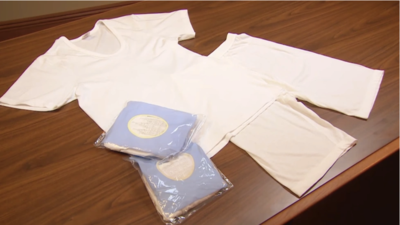
FAIR is a non-profit organization dedicated to providing well-documented answers to criticisms of the doctrine, practice, and history of The Church of Jesus Christ of Latter-day Saints.
FAIR Answers—back to home page

Members of The Church of Jesus Christ of Latter-day Saints perform several sacred ordinances or ceremonies for individuals that they believe are necessary for individual exaltation. A few of these ceremonies are performed in temples: holy places dedicated to serving God.
As part of ceremonies in the temple known as “initiatories,” individuals put on sacred underclothes to symbolize some of the sacred promises that they make in the temple as well as sacred knowledge conferred to them. These underclothes are commonly referred to as "the temple garment," "temple garments," "the garment," or simply "garments."
Members of the Church who go through these ceremonies and put on these sacred garments are sometimes confused as to two things:
This article seeks to answer these two questions given what we know from the temple and other official Church sources.
According to the official leadership handbook of the Church, “[m]embers who receive the endowment make a covenant to wear the temple garment throughout their lives.” A "covenant" is defined by the Church (and, indeed, by most dictionaries) as “a sacred agreement between God and a person or group of people. God sets specific conditions, and He promises to bless us as we obey those conditions.”
In the temple, we are instructed to wear the garment throughout our life, to not defile it, and to remain true to the other covenants we make in the temple. In exchange, the garment will serve as a spiritual shield and protection (and what good does a shield that isn't worn do?).This clearly follows the definition of “covenant” above. It is understandable and forgivable that confusion would arise on the issue since the endowment does not explicitly state that you receive the garment by covenant, but the instruction given plus the blessings promised for complying with that instruction clearly fall in line with the definition of covenant.
To “defile” means to violate the sanctity of something. To not wear garments when you have the reasonable opportunity to wear them (as discussed below) certainly falls in line with this definition.
The official leadership handbook section on wearing the garment states that “[t]he garment should not be removed for activities that can reasonably be done while wearing the garment. It should not be modified to accommodate different styles of clothing. The garment is sacred and should be treated with respect. Endowed members should seek the guidance of the Holy Spirit to answer personal questions about wearing the garment.” What are those activities where it might be unreasonable to wear the garment? Examples might include intimate relations between husband and wife, any period of intensive exercise, and any aquatic activity.
As the quote states, the garment should not be removed nor modified to accommodate different styles of clothing. One of the purposes of the garment is to encourage modesty in how we dress. The garment as currently designed indicates what parts of the body should be clothed in order to meet a more objective/specific standard of modesty in how we dress.
Some have been concerned about having to be in extreme heat when wearing the garment. Being in extreme heat may be a time to reasonably remove the garment. However, if one would like to try not to remove the garment, it should be understood that retailers that sell garments carry them in a number of different fabric types to accommodate this. The chart below lists the different fabric types.
 Some women have been concerned about the garment causing yeast infections and/or urinary tract infections. It should be noted that all garment styles for women "have a 100% cotton bottom panel for breathability and hygiene, as recommended by OBGYNs."[1]
Some women have been concerned about the garment causing yeast infections and/or urinary tract infections. It should be noted that all garment styles for women "have a 100% cotton bottom panel for breathability and hygiene, as recommended by OBGYNs."[1]
Some have been concerned about potential skin allergies that garments might cause. As noted above, there are several different styles of fabric that one can choose from in order to avoid allergies.
Some have been concerned about the itchiness of certain fabrics. The chart above gives ratings for how soft and comfortable each fabric style is. Consumers can pick what works best for their circumstances.
Special styles of garments exist for women who are pregnant and/or nursing and for those that are terminally ill and/or bedridden for an extended period of time.
The basic notion that the author wishes to instill in the reader is that garments should not be removed when we have the reasonable opportunity to wear them. Why would there be so many fabrics and styles that one can choose from if the Church didn't expect us to wear them as much as possible?
There may yet be questions that arise about wearing the garment given different practical and/or health concerns. These might be directed to God in prayer, a local bishop, a local stake president, and/or a local temple worker. You might also consider emailing [email protected]. This email is directed to those in the Temple Affairs Department of the Church who frequently take user feedback about garments to better meet the needs of the wearer.
Wearing the garment is a sacred privilege. They are expressly not "just like any other underwear." Wearing the garment communicates love for God by keeping our covenants with him and love for others by giving them an example to follow that leads them to Jesus Christ.[2] We often want so much to conform our garment-wearing to the world rather than help the world conform to garment-wearing. We shouldn’t be afraid to be different from others. The Lord has told us that, as Christians, we should “[l]et [our] light so shine before men [and women], that they may see [our] good works, and glorify [our] Father which is in heaven.”[3] He wants us to be "a peculiar people, zealous of good works."[4] Being different by wearing our garments and treating them with sacredness is an excellent way that we can humbly follow the Lord and, by so doing, be peculiar and interesting to other people. This interest may lead them to explore the teachings of The Church of Jesus Christ and be converted to it. Thus, by wearing the garment we can fulfill the Lord’s commandments. As Latter-day Saints, we should be model disciples of Jesus Christ. Wearing the garment is one way that we can do that and it brings tremendous spiritual blessings.
Notes

FAIR is a non-profit organization dedicated to providing well-documented answers to criticisms of the doctrine, practice, and history of The Church of Jesus Christ of Latter-day Saints.
We are a volunteer organization. We invite you to give back.
Donate Now